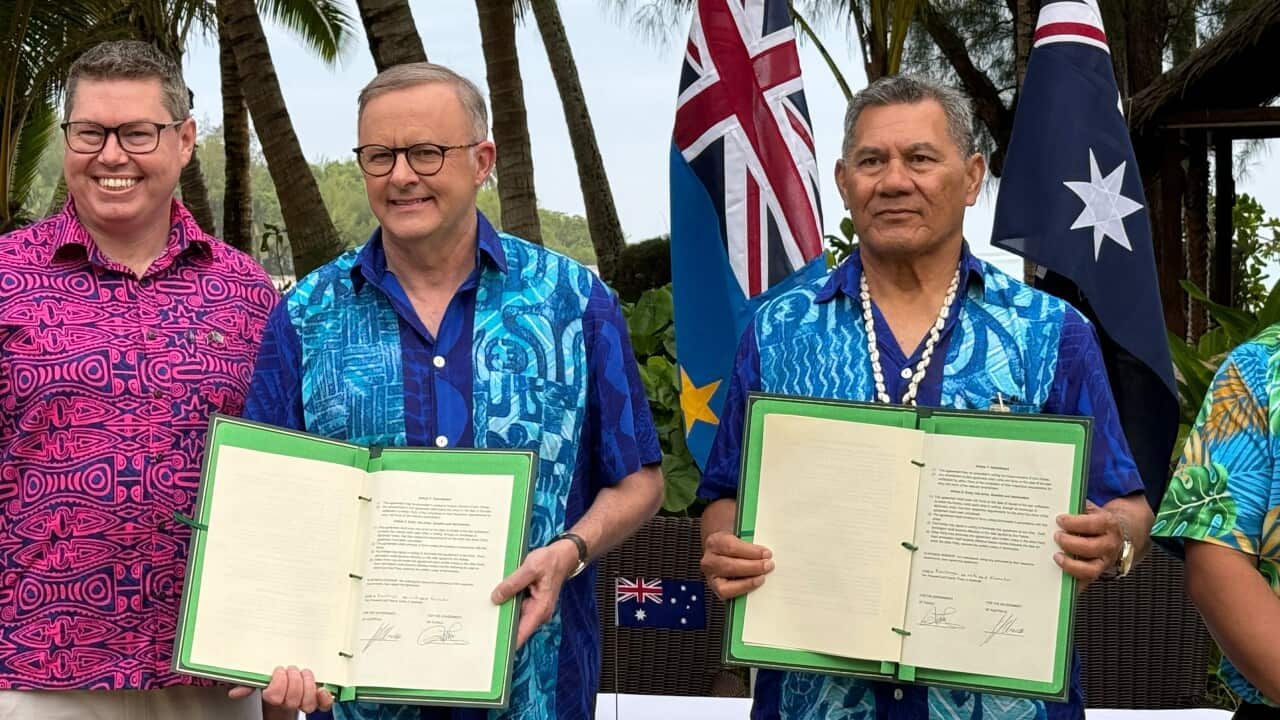Towards the end of 2023, the Albanese government unveiled its long-awaited strategy to reform the country’s migration system.
There are some significant changes set for the new year.
Released by , the strategy included a range of new commitments focused largely on temporary skilled migration and international education.
The government plans to implement many of these throughout 2024 — including stricter English language requirements for student and temporary graduate visas, as well as a new visa for those with in-demand skills.
A raft of previous announcements are also set to come into effect this year — for example, a new visa for Pacific migrants.
The government has outlined areas for future reform, including permanent skilled migration, regional migration and the Working Holiday Maker program, which will be consulted on throughout 2024.
Here’s what we know so far.

The government has released its strategy to reform Australia's migration system, which was deemed "not fit for purpose" by a major review. Source: Getty / Mark Evans
What is the government hoping to achieve with its migration strategy?
Net overseas migration (NOM) is the total number of people who have entered and remained in a country for at least one year, minus those who have left. NOM includes the movements in and out of Australian citizens.
Australia's NOM peaked in 2022-23 at 510,000, according to projections also contained in the government’s mid-year budget update.
The spike was largely due to the return of international students and tourists after the easing of COVID-19 pandemic restrictions.
The government has stressed that NOM isn't an immigration policy target, but the new strategy aims to reduce the figure from 510,000 to the near-pre-pandemic level of 375,000 in the 2023-24 financial year, and then to 250,000 in 2024-25.
"Our goal is to return migration to sustainable levels," O'Neil told reporters in early December.

Home Affairs Minister Clare O’Neil says the government's migration strategy is "a bold plan to get migration working again for all Australians". Source: AAP / Lukas Coch
She said one of the overarching issues is to reduce “permanent temporariness", a state in which people live in Australia on temporary visas and hop from visa to visa to remain in the country.
"Broadly, this strategy is trying to decrease the amount of long-term temporary visa holders and increase pathways to permanent residency, which I think will have a positive impact on social cohesion," she said.
"I'm hopeful the strategy will provide ultimately better-skilled migration, an increase in permanent migration over temporary migration, as well as cracking down on [the] exploitation of migrants, which has become an increasing issue, especially over COVID."
The changes were broadly supported by unions and business groups as being crucial to improving working conditions and boosting the economy.
READ MORE

Australian visa changes for 2023-24
New visa for workers with in-demand skills
Perkins said the biggest change coming is to employer-sponsored visas.
The government is introducing a new four-year temporary skilled worker visa which it says will offer workers more opportunity to change their employer and provide pathways to permanent residency.
Once implemented, the "Skills in Demand" visa will replace the current Temporary Skill Shortage visa (Subclass 482), which permits holders to live in Australia while working full-time for the sponsoring employer.
According to a government timeline of new and existing commitments, this will happen in late 2024.
The visa will be split into three pathways, the first being a specialist skills pathway that expedites applications from highly skilled migrants.
This will be available to those initially earning at least $135,000 in any job excluding trades workers, machinery operators, drivers and labourers.
The government has committed to a median visa processing time of seven days.
Perkins commended efforts to make employer sponsorship more accessible and to provide more options for permanent residency.
She said faster processing times "would be attractive to highly skilled workers".
"In comparison to the rest of the world, we may lose skilled workers just because of how complex and lengthy our employer-sponsored program is," she said.
The second core skills pathway will be available to most temporary skilled migrants whose job is listed on a new Core Skills Occupation List, based on those identified by Jobs and Skills Australia as being in short supply.
Their earnings will need to be at least the income required for the Temporary Skilled Migration Income Threshold (TSMIT).
Earlier in 2023, the government raised the TSMIT from $53,900 to $70,000.
The government will also move to index this threshold annually by the wage price index.
Consultation on regulating migration for lower-paid workers with essential skills – a third pathway – is expected to begin in the first half of 2024.
Harder English language tests — and other changes to student visas
International students and graduates — who, according to the migration strategy, make up the largest share of Australia’s "permanently temporary" migrants — are a big focus of government reforms.
Broadly speaking, the government was "trying to increase the skill level of students who are coming here," Perkins said. "If someone looks like they're not going to have a permanent pathway, they're almost trying to discourage them from coming to Australia to study."
Among other changes are raised English language requirements.
From early this year, those applying for a student visa will need an International English Language Testing System (IELTS) score of 6.0 (up from 5.5) or an equivalent test of English language proficiency such as the Pearson Test of English (PTE), which is becoming more popular among international students choosing Australia as their education destination.
The test score required for a temporary graduate visa will increase from 6.0 to 6.5.
The government says this will improve the quality of students' educational experience and reduce potential workplace exploitation.
A new 'Genuine Student Test'
Australia’s new migration strategy will also introduce a new "Genuine Student Test" for all international students that will replace the existing Genuine Temporary Entrant requirement.
This will "incentivise applications from genuine students and discourage non-genuine students whose primary intention is to work rather than study", the strategy states.
This is expected to be implemented in early 2024.
The government moved to bolster the student visa integrity unit in the Home Affairs Department late last year and will pursue measures to "remove unscrupulous providers" from the system in 2024.
Student visa processing priorities
The government has released new processing priorities for student and student guardian visa applications, based on its commitment to scrutinise those from “high risk providers”.
These are outlined in , based on a rated system of education providers, and applies to all applications lodged on or from 15 December.
More changes to temporary graduate visas
From mid-2024, the government will move to "strengthen and simplify" temporary graduate visas. The changes will include:
An age limit for visa applicants
Under the new settings, applicants will need to be under the age of 35 (down from the current age of 50).
A reduced visa duration
The duration of an initial temporary graduate visa will also be reduced to two years for a bachelor's or master's degree by coursework and three years for a master's by research.
Students in regional areas will be eligible for a second visa of one to two years depending upon their location.
"This is all part of reducing long-term temporary visa holders," Perkins explained.
What has the government already announced?
Phased out COVID concessions
In September 2023, the government announced, which was created in 2020 to enable temporary visa holders to remain in Australia during the COVID-19 pandemic when international borders were closed.
No new applicants were eligible for the visa from 2 September and applications will close entirely from February.
The strategy states phasing out COVID concessions, including discontinuing the Pandemic Event Visa and , will help bring migration numbers to near-pre-pandemic levels.
New visa for Pacific migrants
A new visa for eligible migrants from Pacific countries and Timor Leste is also set to be introduced this year.
The Pacific Engagement Visa (PEV) will enable up to 3,000 nationals from participating countries to migrate to Australia each year as permanent residents.
Legislation passed by the Senate in October will allow the use of a ballot process to randomly select applicants.
If successful, they would then be required to satisfy certain criteria, including having a job in Australia.
In a statement issued in October last year, Minister for Immigration Andrew Giles and Minister for International Development and the Pacific Pat Conroy said the program would commence in 2024 once all remaining legislative and administrative arrangements are approved.
Priority processing for Protection Visa applicants
In October, the government also announced a $160 million package to help strengthen the refugee visa system, after
That included $54 million to create a real-time priority processing of Protection Visa applications "to help break the business model of those who abuse the system".
Perkins said we'll see more of this in 2024.
"It will become more important as we're seeing more people get processed quickly, and get refusals quickly," she said.
What will be on the migration agenda in 2024?
The strategy outlines areas of future reform that require consultation in 2024.
This includes how to regulate migration for lower-paid workers with essential skills and how to reshape permanent skilled migration.
The government plans to look at regional migration and the Working Holiday Maker program to support the regions and its workers. A discussion paper to that end is set to be released early this year.




